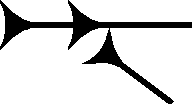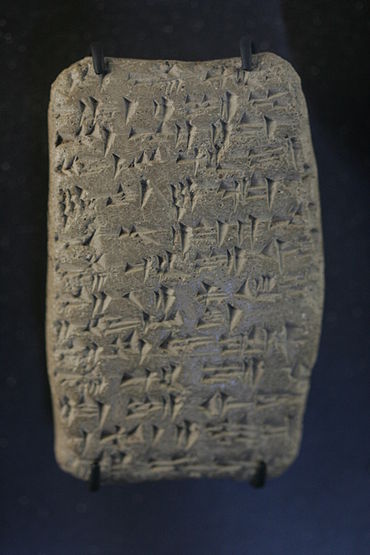The cuneiform qut sign, (also qud, aspirated 't', unaspirated 'd') sign is found in both the 14th century BC Amarna letters and the Epic of Gilgamesh. It is a multi-use sign with 9 syllabic/alphabetic uses in the Epic of Gilgamesh; in the Amarna letters it is extremely common in the prostration formula, typical first paragraph of a letter, saying typically: "7 and 7 times, I bow down" (to the Pharaoh, when addressed to the Pharaoh); a small group of Amarna letters are addressed to a different distinct personage in Egypt, under the Pharaoh.


In Line 6, 2nd character from left, for am-qut, (Akkadian language, maqātu, "to fall, to happen",[1] I bow down) ; text reads left-to-right.
(am-qut).


(high resolution, expandible photo)
In the Epic of Gilgamesh, the sign is used for many syllabic meanings, as well as two Sumerograms, as follows:[2]
- has
- haṣ
- kut
- qud
- qut
- šel
- šil
- tar
- ṭar
- SILA, "street Sumerogram"
- TAR, for Goddess Ishtar's name, DIŠ.TAR
The usage numbers for the sign are as follows in the Epic:[3] has-(2), haṣ-(7), kut-(6), qud-(8), qut-(27), šel-(1), šil-(4), tar-(16), ṭar-(9), SILA-(3), for Akkadian language "sūqu", 'street',[4] TAR-(17), exclusively for Ištar's name.
Usage, letter EA 364 edit
For Amarna letter EA 364, Ayyab to Pharaoh, located in the Louvre (no. AO 7094),[5] the qut sign is only used once, on the clay tablet obverse, line 6.
The following is Rainey's (1970) English language, mostly sequential line-by-line translation, and sign characters, up to line 11:[6]
- (1) "To the king, my lord, (2) thus (speaks) Ayyab, (3) your servant: at (4) the feet of my lord (5) seven times (and) seven times (6) I have fallen down. I am the servant (7) of the king, my lord, ("And" omitted) (8) the dust of (i.e. beneath) (9) his two feet. (10) I have obeyed (lit.: heard) the message (11) of the king, my lord, (12) to me from (13) the hand of ...." (Tahmassi, messenger envoy)
- (1) "a-na šarri(LUGAL) bēli(EN)-ia (2) um-ma A-ia-ab (3) arad(ÌR)-ka a-na! (4) šēpē(GÌR-meš) bēli(EN)-ia (5) 7-šu 7-ta-an (6) am-qut a-na-ku arad (ÌR) (7) šarri(LUGAL) bēli(EN)-ia ("and", ù (u, 2nd prime) omitted, a large 2-sign combinatorial, (ši+ku?, see photo)) (8) SAHAR ("dust Sumerogram") /(2nd omitted 1/2 u, "and") a-pa-ru(=eperu, 'dust'(Akkadian)) (9) 2 šēpē(GÌR-meš)-šu (10) eš(sub 15)(=iš)-te-mé ša-par (11) šarri(LUGAL) bēli(EN)-ia (12) a-na ia-ši i-na (13) qa-ti 1. A-tah-ma-ia (Tahmassi) (14) ...."
Lines 7 and 11, have the repetition, "King-Lord-mine" from Line 1 (LUGAL-EN-ia, "Šarri-Bēli-ia" for the Akkadian).
Akkadian maqātu, "to fall", "to happen" edit
The phrase: ...7 and 7 times, "I bow (down)".... is extremely prominent in the Amarna letters, and especially from the letters from the Canannite city-states. The Akkadian language word is "maqātu",[7] to fall, to happen, etc., and has various spellings requiring an m, q-(or equivalent (k)), and t. One of the commonest spellings are the two cuneiform signs am-qut.
References edit
- ^ Parpola, 1971. The Standard Babylonian Epic of Gilgamesh, Glossary, pp. 119-145, maqātu, to fall, to happen, p. 131.
- ^ Parpola, 1971. The Standard Babylonian Epic of Gilgamesh, Sign List, pp. 155-165, no. 012, p. 155.
- ^ Parpola, 1971. The Standard Babylonian Epic of Gilgamesh, Sign List, pp. 155-165, no. 012, p. 155.
- ^ Parpola, 1971. The Standard Babylonian Epic of Gilgamesh, Glossary, pp. 119-145, sūqu, p. 139.
- ^ Rainey, 1970. El Amarna Tablets, 359-379, EA 364, Ayyāb of Ashtartu to the King, pp. 22-23.
- ^ Rainey, 1970. EA 364, Ayyāb of Ashtartu to the King, pp. 22-23.
- ^ Parpola, 1971. The Standard Babylonian Epic of Gilgamesh, Glossary, pp. 119-145, maqātu, to fall, to happen, p. 131.
- Moran, William L. 1987, 1992. The Amarna Letters. Johns Hopkins University Press, 1987, 1992. 393 pages.(softcover, ISBN 0-8018-6715-0)
- Parpola, 1971. The Standard Babylonian Epic of Gilgamesh, Parpola, Simo, Neo-Assyrian Text Corpus Project, c 1997, Tablet I thru Tablet XII, Index of Names, Sign List, and Glossary-(pp. 119–145), 165 pages.
- Rainey, 1970. El Amarna Tablets, 359-379, Anson F. Rainey, (AOAT 8, Alter Orient Altes Testament 8, Kevelaer and Neukirchen -Vluyen), 1970, 107 pages.